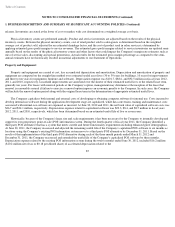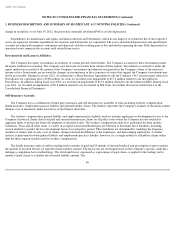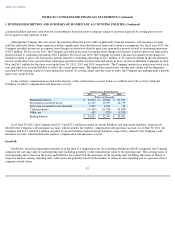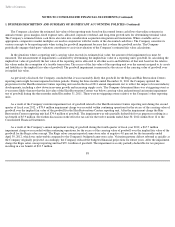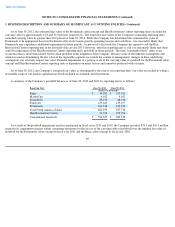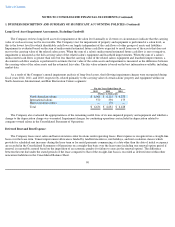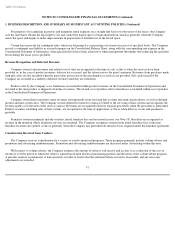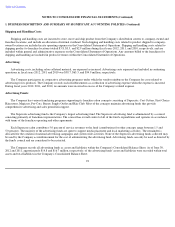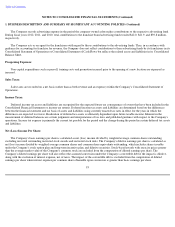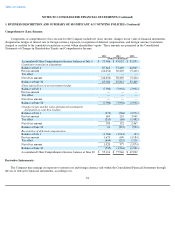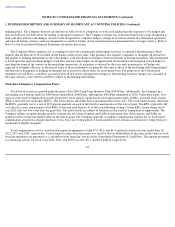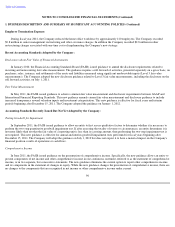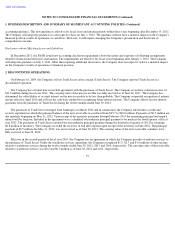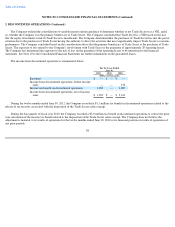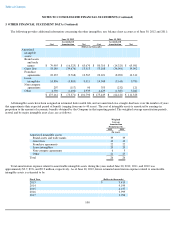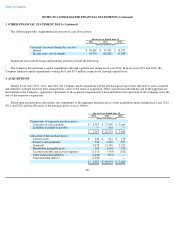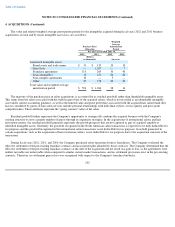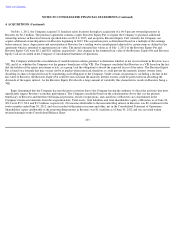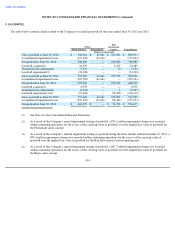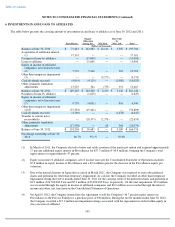Supercuts 2012 Annual Report Download - page 98
Download and view the complete annual report
Please find page 98 of the 2012 Supercuts annual report below. You can navigate through the pages in the report by either clicking on the pages listed below, or by using the keyword search tool below to find specific information within the annual report.
Table of Contents
NOTES TO CONSOLIDATED FINANCIAL STATEMENTS (Continued)
1. BUSINESS DESCRIPTION AND SUMMARY OF SIGNIFICANT ACCOUNTING POLICIES (Continued)
hedging policy. The Company does not use derivatives with a level of complexity or with a risk higher than the exposures to be hedged and
does not hold or issue derivatives for trading or speculative purposes. The Company currently has or has had interest rate swaps designated as
both cash flow and fair value hedges, treasury locks designated as cash flow hedges, a hedge of its net investment in its European operations
and forward foreign currency contracts designated as cash flow hedges of forecasted transactions denominated in a foreign currency. Refer to
Note 9 to the Consolidated Financial Statements for further discussion.
The Company follows guidance for accounting for derivative instruments and hedging activities, as amended and interpreted, which
requires that all derivatives be recorded on the balance sheet at fair value. This guidance also requires companies to designate all derivatives
that qualify as hedging instruments as fair value hedges, cash flow hedges or hedges of net investments in foreign operations. This designation
is based upon the exposure being hedged. Cash flow and fair value hedges are designated and documented at the inception of each hedge by
matching the terms of the contract to the underlying transaction. At inception, as dictated by the facts and circumstances, all hedges are
expected to be highly effective, as the critical terms of these instruments are generally the same as those of the underlying risks being hedged.
All derivatives designated as hedging instruments are assessed for effectiveness on an on-going basis. For purposes of the Consolidated
Statement of Cash Flows, cash flows associated with all derivatives (designated as hedges or freestanding economic hedges) are classified in
the same category as the related cash flows subject to the hedging relationship.
Stock-Based Employee Compensation Plans:
Stock-based awards are granted under the terms of the 2004 Long Term Incentive Plan (2004 Plan). Additionally, the Company has
outstanding stock options under its 2000 Stock Option Plan (2000 Plan), although the 2000 Plan terminated in 2010. Under these plans, four
types of stock-based compensation awards are granted: stock options, equity-based stock appreciation rights (SARs), restricted stock awards
(RSAs) and restricted stock units (RSUs). The stock options and SARs have a maximum term of ten years. The stock-based awards, other than
the RSUs, generally vest at a rate of 20.0 percent annually on each of the first five anniversaries of the date of grant. The RSUs generally cliff
vest after five years, and payment of the RSUs is deferred until January 31 of the year following vesting. Certain RSUs issued during fiscal
year 2012 cliff vest two years after the grant date. Unvested awards are subject to forfeiture in the event of termination of employment. The
Company utilizes an option-pricing model to estimate the fair value of options and SARs at their grant date. Stock options and SARs are
granted at not less than fair market value on the date of grant. The Company generally recognizes compensation expense for its stock-based
compensation awards on a straight-line basis over a five-year vesting period. Awards granted do not contain acceleration of vesting terms for
retirement of eligible recipients.
Total compensation cost for stock-based payment arrangements totaled $7.6, $9.6, and $9.3 million for the fiscal years ended June 30,
2012, 2011 and 2010, respectively. Cash retained for share based payments as a result of the tax deductibility of increases in the value of stock-
based arrangements are presented as a cash inflow from financing activity in the Consolidated Statement of Cash Flows. The amount presented
as a financing activity for fiscal years 2012, 2011, and 2010 was zero, $0.1, and $0.2 million, respectively.
95


